Isn’t it frustrating when customer inquiries are not met on time, goes on long hold, and to make things worse, they have limited access to your business information?
78% of customers drop out of a purchasing decision if they aren’t satisfied with customer support and this is where optimizing multi-channel or omni-channel communications is the need of the hour.
There were times when customer support was primarily carried out through call centers staffed by human agents, who faced the daunting challenge of handling a high volume of calls, often resulting in extended wait times and inconsistent service quality.
Call center software stepped in to change this narrative dramatically. It introduced features like intelligent call routing, ensuring that customers were swiftly connected to the most appropriate agent or department.
Interactive voice response (IVR) systems streamlined the process further by allowing customers to navigate through options and even access self-service features.
Call center software changed the game by providing advanced analytics and reporting features. Organizations could now gather valuable insights, identify trends, and make data-driven decisions to continuously improve their communication processes and customer service.
We get it that you get it about how important Call center Software is, however, what most of us don’t know is how to choose the right call center software. Is there a guidebook? Well, there is one now. Keep reading 🙂
What is Call Center Software?
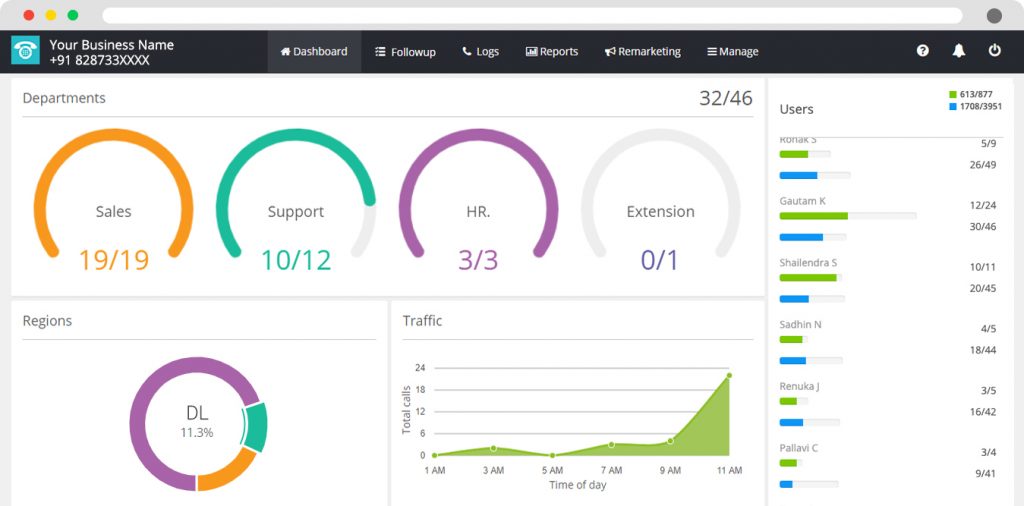
Call Center Software is a specialized set of digital tool designed to help businesses efficiently manage their customer interactions from one central account.
It includes features like call routing, interactive voice response (IVR) systems, analytics, and customer relationship management (CRM) integration, enabling organizations to handle and optimize customer inquiries, streamline internal communication, and gather valuable data insights for better decision-making.
In essence, call center software enhances the way businesses communicate with their customers and within their teams, ultimately improving customer service and operational efficiency.
How to Confirm Whether a Business Needs Call Center Software?
Determining whether a business needs call center software involves assessing various factors and conducting a thorough analysis of its communication and customer service needs.
Here’s a step-by-step approach to confirm whether your business requires a call center software solution
Evaluate Current Communication Channels
Start by assessing how your business currently handles customer interactions and inquiries. Consider the following:
- Call Volume: Are you receiving a high volume of phone calls from customers?
- Omni-Channel Strategy: Are you looking to implement an omni-channel communication strategy to provide a unified customer experience?
- Customer Feedback: Are you actively collecting customer feedback and inquiries through various channels to improve your products or services?
- Remote Work: Do you require a call center software solution that supports remote work capabilities for your agents handling communication across these channels?
If you find that your current communication channels are struggling to keep up with demand, it may be an indicator that a cloud call center solution is needed.
Assess Customer Expectations
Consider the expectations of your customers. Are they looking for quicker response times, extended support hours, or multichannel communication options?
Customer feedback and complaints can provide valuable insights into whether your business needs to improve its communication capabilities.
Analyze Workforce Efficiency
Examine how efficiently your employees are handling customer inquiries. Signs that you might need call center software include:
- Long Wait Times: Customers spending excessive time on hold or waiting for responses.
- Overwhelmed Staff: Your team is struggling to manage call volumes, leading to stress and reduced productivity.
- Inconsistent Service: Service quality varies due to human limitations.
Consider Business Goals
Align your decision with your business objectives. If you plan to expand, reach new markets, or offer 24/7 support, call center software can be instrumental in achieving these goals.
Assess Cost and Resource Management
Calculate the costs associated with your current customer service setup. Are you spending more on staffing and infrastructure than you would with a call center solution?
Evaluate whether the investment in a call center software solution would lead to cost savings over time.
Forecast for Growth
Consider your business’s growth trajectory. If you anticipate an increase in customer inquiries or plan to diversify your product or service offerings, call center software can provide the scalability needed to accommodate these changes.
Industry and Customer Demands
Assess industry standards and customer expectations. In some industries, a robust customer service infrastructure is a competitive necessity.
Regulatory Compliance
If your business operates in a regulated industry (e.g., healthcare or finance), compliance requirements may necessitate specific communication and data management capabilities that call center software can provide.
Customer Feedback and Surveys
Conduct customer surveys or gather feedback to gauge satisfaction with your current communication channels. Customers’ responses can reveal areas where improvements are needed.
Competitive Analysis
Analyze how your competitors handle customer service and communication. If they have adopted call center software and are gaining a competitive edge, it may be a sign that your business should consider it as well.
Pilot or Trial Period
Consider running a pilot program or a trial period with call center software to assess its impact on your business. This can provide tangible data and insights into its effectiveness.
Ultimately, the decision to implement call center software should align with your business’s specific needs, goals, and budget.
Careful consideration and analysis will help confirm whether such software is the right solution to enhance your communication and customer service capabilities.
8 Key Points To Check Before Opting For A Call Center Software Provider
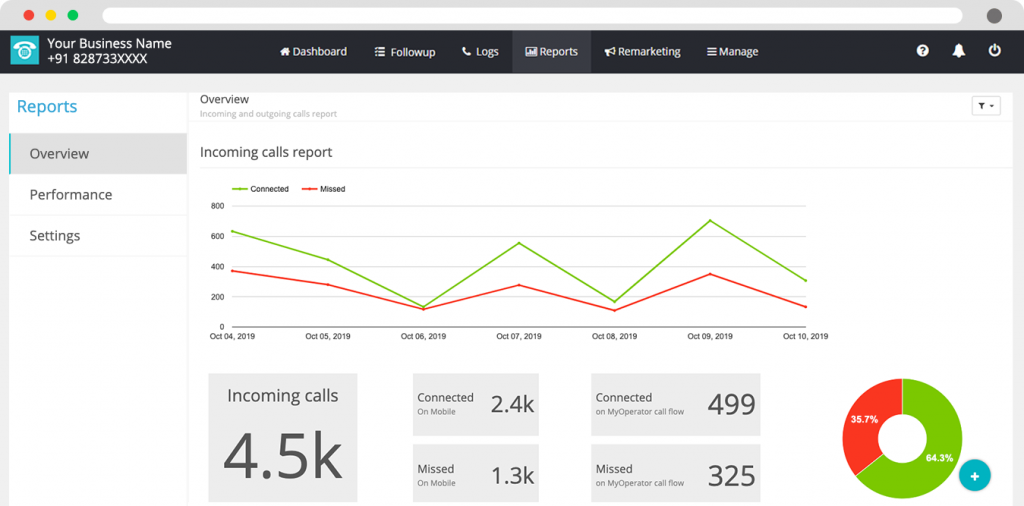
1. Ease of Use
User-Friendly Interface: The software should have an intuitive and user-friendly interface that minimizes the learning curve for agents and supervisors. A clean and organized layout can enhance efficiency and reduce training time.
Customization: Look for software that allows you to customize the interface to match your specific workflow and processes. This adaptability ensures that the software aligns with your business needs.
2. Future Scalability and Brand Authenticity
Scalability: Consider whether the software can easily adapt to the changing needs of your business. It should accommodate a growing customer base, increasing call volumes, and evolving communication channels without significant disruptions.
Brand Authenticity: Ensure that the call center software supports your brand’s identity and maintains consistency in customer interactions. This includes customizable scripts, greetings, and branding elements.
3. On-Premises Call Center Software
Advantages: On-premises solutions provide greater control over your infrastructure and data. They are suitable for businesses with specific security and compliance requirements.
Drawbacks: On-Premise call centers are costlier to set up and maintain. They require more IT expertise and may lack the scalability and flexibility of cloud-based alternatives. Additionally, data recovery and security is a major concern when it comes to on-premise call centers.
4. Cloud-Based Call Center Software
Advantages: Cloud-based solutions offer flexibility, scalability, and accessibility from anywhere with an internet connection. They often have lower upfront costs, automatic updates, and disaster recovery features.
Drawbacks: Security and data privacy concerns may arise, depending on the vendor and deployment model. Monthly subscription fees can accumulate over time.
5. CRM Integration
Efficient Customer Management: Integration with a Customer Relationship Management (CRM) system is crucial for accessing customer data, history, and preferences. This enables agents to provide more personalized and efficient support.
Streamlined Workflows: CRM integration ensures that customer interactions are seamlessly logged and tracked within the software, reducing manual data entry and errors.
6. Customer and Technical Support
Responsive Customer Support: The call center software provider should offer responsive customer support. Quick resolution of technical issues or questions is essential to avoid downtime and disruptions.
Training Resources: Look for a vendor that provides comprehensive training resources, including documentation, tutorials, and webinars, to help your team make the most of the software.
7. Disaster Recovery and Business Continuity
Data Backup: Ensure the software has robust data backup and recovery mechanisms in place to protect against data loss in case of hardware failures or other disasters.
Redundancy: Consider options for redundancy and failover to maintain uninterrupted operations even in challenging situations.
8. Price
Total Cost of Ownership: Evaluate the total cost of ownership, including upfront costs, ongoing subscription fees, maintenance expenses, and potential customization or integration costs.
Budget Alignment: Choose a call center software solution that aligns with your budget constraints while still meeting your essential requirements.
Taking these factors into account when selecting call center software ensures that you choose a solution that not only meets your current needs but also supports your long-term goals and brand authenticity while being user-friendly and cost-effective.
What Features Should Your Call Center Software Include?
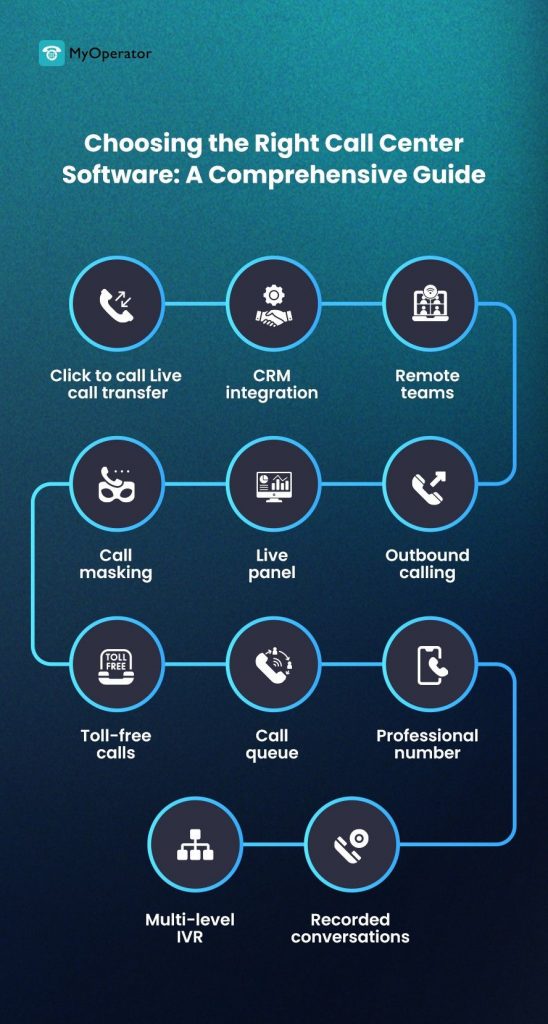
1. Omni-Channel Support
Explanation: Omni-channel support enables your call center to handle inquiries and interactions across various communication channels, including phone calls, emails, chats, social media, and more.
Benefits: Omni-channel support ensures that you can engage with customers on their preferred platforms, providing a seamless and consistent experience.
2. Toll-Free Number Calls
Explanation: A toll-free number provides the most customization reputation for your company in the eyes of customers as they see a designated free company call number.
Integrating your call center software with toll-free service to let customers and prospects call you for free, is a solution that doubles your customer engagement.
Benefits: Toll-free numbers make it easier for customers to reach your business, fostering greater accessibility and customer satisfaction. Customers can connect with your call center without incurring call charges, encouraging more inquiries and interactions
3. Interactive Voice Response (IVR)
Explanation: IVR systems use automated voice menus to allow callers to interact with the system and access information or perform tasks without agent intervention.
Benefits: IVR service enhances self-service options, reduces call volume, and can handle routine tasks.
4. Outbound Calling
Explanation: Outbound calling enables your call center software to initiate automatic calls to potential customers or clients, while also allowing for Interactive Voice Response (IVR) inputs, streamlining the communication process.
Benefits: Outbound calling solutions increases efficiency by reaching out to a wider audience, while IVR inputs enhance customer interaction, ensuring quicker and more effective responses, and ultimately boosting sales and engagement.
4. Call Queues
Explanation: Call queues hold incoming calls in line until an agent becomes available. Callers hear music or messages while waiting.
Benefits: Call queues prevent call abandonment and allow for orderly handling of incoming calls.
5. Call Recording
Explanation: Call recording captures and stores audio or video recordings of customer-agent interactions.
Benefits: Recording calls aid in quality assurance, dispute resolution, training, and compliance.
6. Call Monitoring
Explanation: Call monitoring allows supervisors to listen in on live calls or review recorded calls to ensure quality and compliance.
Benefits: Monitoring helps maintain service quality, provide feedback to agents, and identify areas for improvement.
7. KPI Measuring and Reporting
Explanation: Call center software should offer robust reporting and analytics tools to measure key performance indicators (KPIs) and generate reports.
Benefits: Data-driven insights enable informed decision-making, performance assessment, and continuous improvement.
8. CRM Integration
Explanation: CRM integration allows agents to access customer data and history within the call center software, improving personalization and efficiency.
Benefits: Seamless CRM integration streamlines workflows and enhances customer interactions.
9. Skill-Based Routing
Explanation: Skill-based routing directs calls to agents with the most relevant skills or expertise to handle specific inquiries.
Benefits: This ensures that customers are connected to the right agents, improving first-call resolution rates.
10. Call Transfer and Conferencing
Explanation: Agents should have the ability to transfer calls to other agents or departments and initiate conferencing with multiple parties.
Benefits: Efficient call handling and collaboration among agents when complex issues arise.
11. Live Panel
Explanation: Real-time dashboards provide live, visual representations of call center performance metrics, allowing supervisors to monitor operations.
Benefits: Real-time insights enable immediate response to issues and efficient resource allocation.
12. Voicemail and Call Back Options
Explanation: Voicemail allows callers to leave messages, and call back options enable customers to request a callback when agents become available.
Benefits: These features enhance customer convenience and support, especially during peak call times.
13. Customization and Flexibility
Explanation: The software should offer customization options to adapt to your unique business processes and requirements.
Benefits: Customization ensures that the software aligns perfectly with your specific needs.
14. Remote Agent Support
Explanation: The software should enable remote work capabilities, allowing agents to work from anywhere with internet access.
Benefits: Remote agent support enhances flexibility and business continuity, especially in remote or unforeseen circumstances.
15. Customer Feedback and Survey Integration
Explanation: Integration with customer feedback and survey tools allows for gathering and analyzing customer opinions and sentiments.
Benefits: Customer feedback provides valuable insights for continuous improvement and enhancing customer satisfaction.
16. Easy for Supervisors to Use
Explanation: Supervisors should find the software user-friendly for monitoring and managing call center operations.
Benefits: An intuitive supervisor interface improves efficiency in overseeing agent performance and call center activities.
MyOperator – The Perfect Call Center Software Solution For Your Business
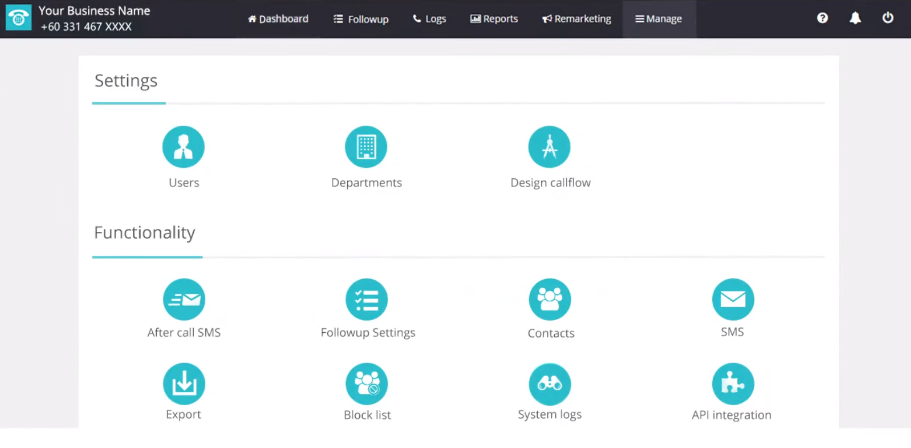
MyOperator’s call center software reigns supreme as the optimal solution for businesses facing contemporary communication challenges.
With a user-friendly interface, seamless integration of IVR customer care number, and advanced call management capabilities, it effortlessly boosts efficiency and customer satisfaction.
The platform’s adaptability to remote work and robust features, including predictive dialing and quality management, solidify its status as the top choice.
Add to this its cost-effectiveness and responsive customer support, and it becomes evident that MyOperator stands as the best call center software to conquer today’s communication demands.
Let’s explore the advanced call center software features in detail:
Multi-level IVR
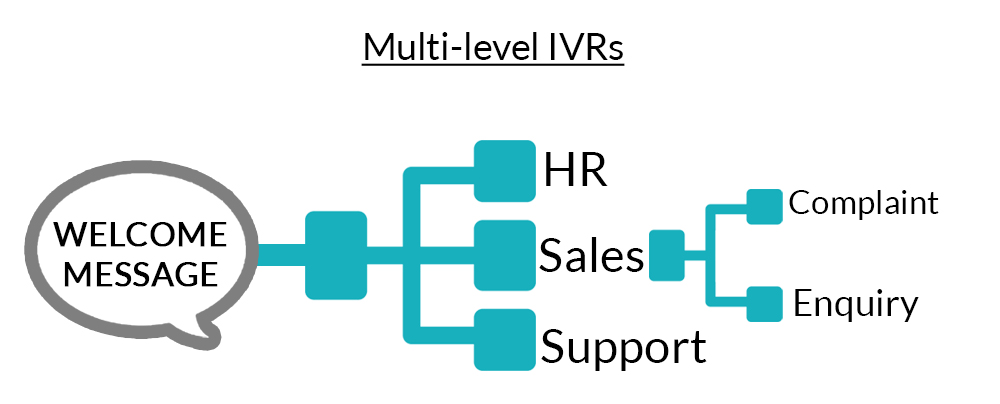
Imagine your business is like a well-structured building with different departments, each responsible for specific tasks. Now, think of Multi-level IVR as the receptionist in this building, directing visitors to the right department with a friendly greeting.
With MyOperator’s Multi-level IVR solution, you can set up a sophisticated phone menu system that reflects the various departments within your organization. For instance, you might have a sales department, a customer support team, and a billing department. Each of these deserves its own space in the virtual “building” of your business.
Here’s how it plays out: When a customer calls your business, they’re greeted with a professional voice message that says something like, “Welcome to XYZ Company. Press 1 for Sales, 2 for Customer Support, and 3 for Billing.” This is your Multi-level IVR at work.
Let’s say the customer presses “2” for Customer Support. They’re then greeted with another message tailored specifically for this department. This ensures that the customer feels they’re in the right place, speaking with the right people who can address their needs.
MyOperator’s Multi-level IVR doesn’t just create a streamlined experience for your customers; it also optimizes your call management. Calls are automatically routed to the appropriate department, reducing confusion and wait times.
So, in essence, MyOperator’s Multi-level IVR feature is like having a virtual receptionist who guides your callers to the right rooms within your business “building.”
It’s all about providing an organized and efficient experience for your customers, ensuring they always connect with the right people who can assist them promptly and professionally.
Toll-Free Number
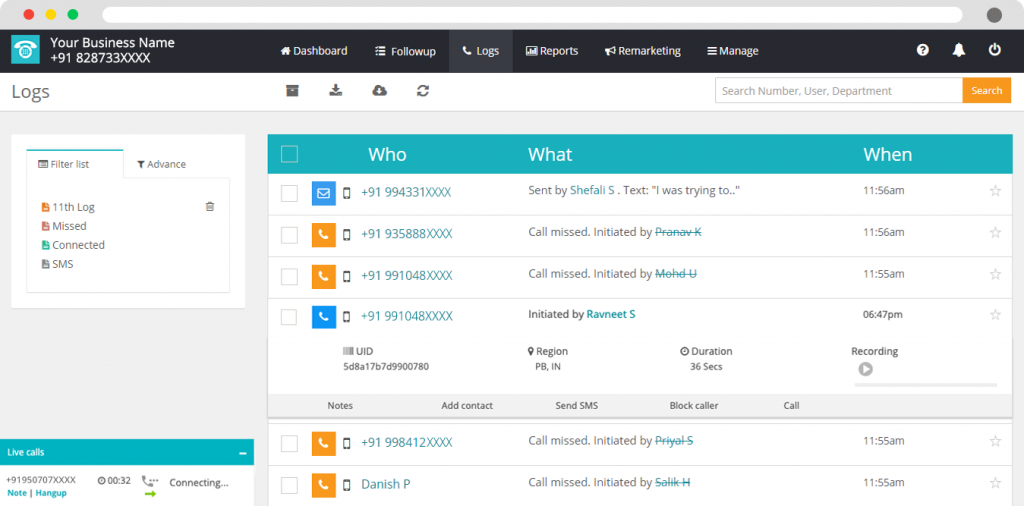
Explanation: Imagine you’re a customer trying to get in touch with a business. You pick up the phone, dial their number, and then you see something wonderful – it’s a toll-free number.
What does that mean for you? It means you can call that business for free, without worrying about those pesky call charges that can sometimes discourage you from making the call in the first place.
Now, let’s talk about how MyOperator makes this a reality. With MyOperator’s call center software, businesses can seamlessly integrate toll-free services for business into their operations.
Improves Customer Care Experience with Toll-free number
Discover Better Support, Happier Customers

Customers and prospects can dial a designated toll-free number anytime, day or night, without being charged for the call.
For instance, let’s say you run a small e-commerce business, and you’ve decided to get a toll-free number from MyOperator.
Your customers appreciate this because they can call your business without hesitation whenever they have a question about a product, need assistance with an order, or simply want to provide feedback. They know it won’t cost them a dime, which makes them more likely to reach out and engage with your business.
So, in a nutshell, MyOperator’s toll-free number feature not only helps businesses provide excellent customer service but also encourages more interactions with customers, ultimately leading to better engagement and stronger relationships.
It’s a win-win for both businesses and their valued customers.
Professional Virtual Number
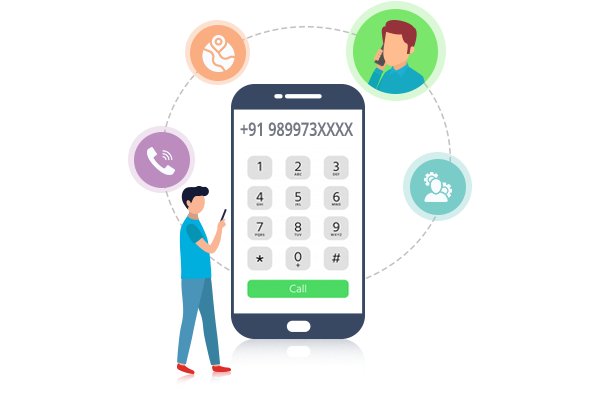
Imagine you’re running a small business, and you want to give it a professional touch. One way to do that is by having a dedicated business number. This not only makes your business look more credible but also gives your customers an easy and free way to connect with you.
That’s where MyOperator’s virtual number feature comes into play. With this feature, you can have a professional business phone number that sets you apart from the crowd. It’s not just any number; it’s one that speaks volumes about your brand.
Here’s how it works: Let’s say you run a cozy little bakery, and you’ve decided to get a virtual number from MyOperator. When your customers see that number, they instantly know they’re reaching your bakery. And here’s the best part – they can connect with you without any calling cost. It’s a win-win situation!
For instance, someone wants to place a big cake order for an upcoming celebration. They spot your professional virtual business number and dial it right away. You answer the call, discuss the details, and provide excellent customer service, all while reinforcing your bakery’s professional image.
So, in a nutshell, MyOperator’s professional virtual business number feature is a game-changer for businesses of all sizes. It elevates your brand image and ensures that your customers can reach you easily and at no cost, fostering trust and loyalty. It’s about making your business look and feel as professional as it truly is.
Click to call
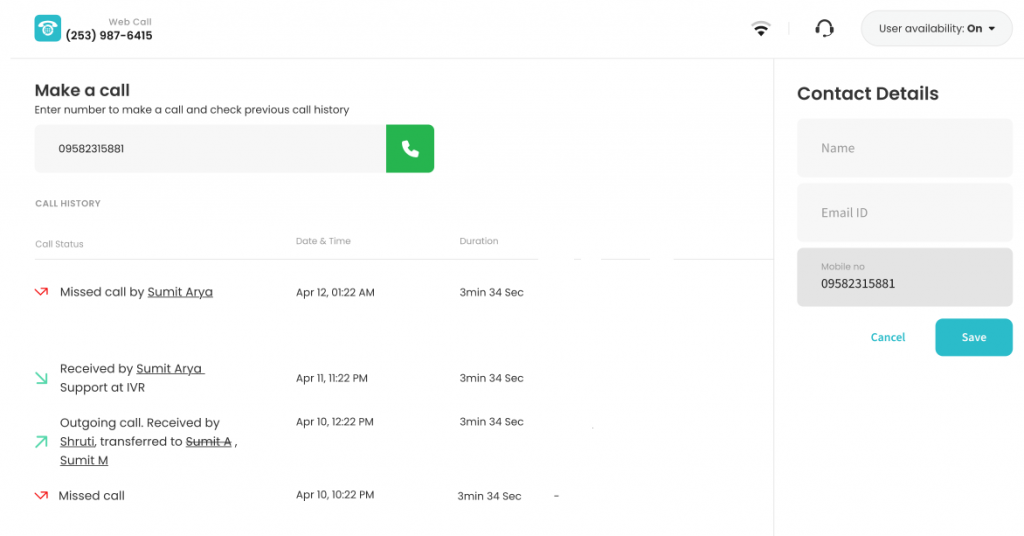
Picture this: You’re a salesperson eager to reach out to potential customers, but the thought of manually calling all those phone numbers one by one feels like a daunting task.
That’s where the Click to call feature comes in – it’s like having a personal assistant to make those calls for you.
Now, let’s dive into how MyOperator’s click-to-call feature makes it all incredibly simple. Imagine you have a list of leads or prospects you want to connect with. Instead of spending precious minutes punching in each number, you log into your MyOperator call center software.
In your dashboard, you see your list of leads. With just one click on each contact, your call is initiated automatically.
No more dialing, no more waiting – it’s swift and efficient. Plus, your MyOperator software can even log these calls, making it easy for you to keep track of your interactions.
For instance, let’s say you’re a real estate agent. You’ve got a list of potential buyers who’ve shown interest in a property. You load up your list in MyOperator, and with a simple click on each prospect’s name, the software dials the number, and you’re instantly connected. It’s a huge time-saver!
MyOperator’s Click to call feature is all about boosting productivity. Whether you’re in sales, customer support, or any field where you need to make multiple calls, this feature streamlines the process, allowing you to focus on what matters – your conversations with customers and prospects. It’s like having a supercharged phone that works at the speed of a click.
CRM Integrations
CRM integration is like having a magic bookmark that helps you find the right page instantly.
So, here’s how MyOperator’s CRM integration works: Let’s say you’re a customer support agent, and you’re on a call with a valued client.
You need to access their past interactions, purchase history, and preferences quickly to provide the best service. That’s where CRM integration comes into play.
With MyOperator, your call center software is connected to your CRM system. As soon as the customer’s call is connected, a magical link is established.
This link fetches all the relevant information about the customer from your CRM and displays it on your screen. It’s like having their entire history right in front of you.
For example, if you’re in the insurance business, you can instantly see the caller’s policy details, previous claims, and any outstanding issues. Armed with this information, you can provide a personalized and efficient service.
No more asking customers to repeat their story or digging through files – it’s all there, at your fingertips.
CRM integration isn’t just a time-saver; it’s a customer service booster. It ensures that every interaction feels personal and informed, leading to higher customer satisfaction. Plus, it streamlines your workflow, making your team more efficient.
Live Call Transfer
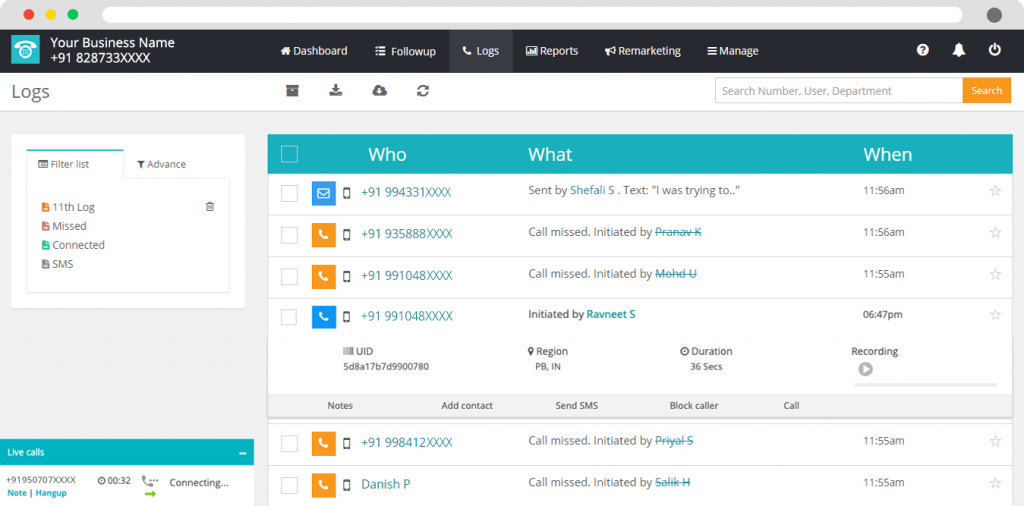
Think of this scenario: You’re on a customer service call with a representative, discussing an issue, and suddenly realize that your query falls under another department’s expertise. In the past, you might have been asked to hang up and call again. But with Live call transfer, it’s a seamless transition, just like passing a baton in a relay race.
Here’s how it works with MyOperator’s Live call transfer feature: You’re a customer calling your favorite online store’s support line, and you’re connected with a friendly agent. You explain your issue, and then you find out that it involves a technical problem, which falls under the IT department’s domain.
Instead of hanging up and redialing, the agent assures you that they’ll transfer your call directly to the IT department while you’re still on the line. In the blink of an eye, you’re speaking with the right expert who can resolve your technical issue.
For businesses, this feature is a game-changer. It minimizes customer frustration, reduces call abandonment rates, and ensures that every customer query lands in the right hands. It’s all about delivering efficient and uninterrupted support, making sure your customers leave the call satisfied and with their issues resolved.
Call Queue
Imagine you’re running a popular customer support line for your online store, and there’s a sudden surge in incoming calls. You want to ensure that every customer gets the attention they deserve without waiting forever. That’s where the Call queue feature comes to your rescue – it’s like an efficient line manager at a bustling store.
Here’s how the Call queue feature operates: On a busy day, when multiple customers call your support line simultaneously, they may hear a friendly automated message saying something like, “Thank you for calling XYZ Store. All our agents are currently assisting other customers. Please stay on the line, and your call will be answered shortly.”
Now, let’s look at it from a customer’s perspective. They appreciate the acknowledgement, and instead of getting frustrated, they decide to hold on because they know they’re in line to talk to a real person who can help them.
As customers wait in the Call queue, the system keeps track of who’s been waiting the longest. When an agent becomes available, the customer who’s been waiting the longest is connected to that agent. It’s like a well-organized queue at a busy restaurant – the first one to arrive gets seated first.
For example, imagine a customer, Sarah, calls your online store with a question about her order. The line is quite busy, but Sarah decides to stay on the line because she really needs assistance.
Thanks to Call queue, she doesn’t have to guess when her turn will come. She’s informed and assured that her call will be answered shortly.
Recorded Conversations
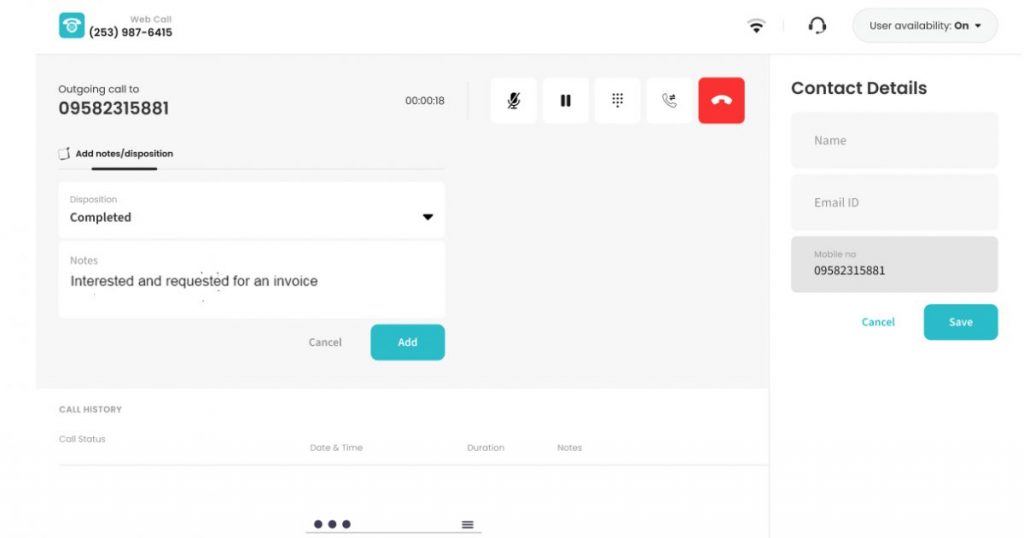
Imagine you’re a manager at a bustling call center, and you want to ensure that your sales and support teams are delivering top-notch service to your customers. But how can you do that effectively?
That’s where the Recorded conversations feature steps in – it’s like having a playback button for your team’s interactions with customers.
Here’s how MyOperator’s Recorded conversations feature works: Every call that goes through your call center is automatically recorded. These recordings serve as valuable training tools for your teams.
For instance, let’s say you run a tech support call center. Your team members handle a wide range of technical queries from customers. With Recorded conversations, you have access to a treasure trove of real customer interactions.
You can listen to these calls to identify areas where your agents excel and where they might need a little extra training. Maybe you come across a call where an agent expertly resolved a complex issue, and you want to highlight that as a best practice.
On the other hand, you might stumble upon a call where a customer’s concern wasn’t fully addressed, giving you an opportunity for coaching and improvement.
Outbound Calling
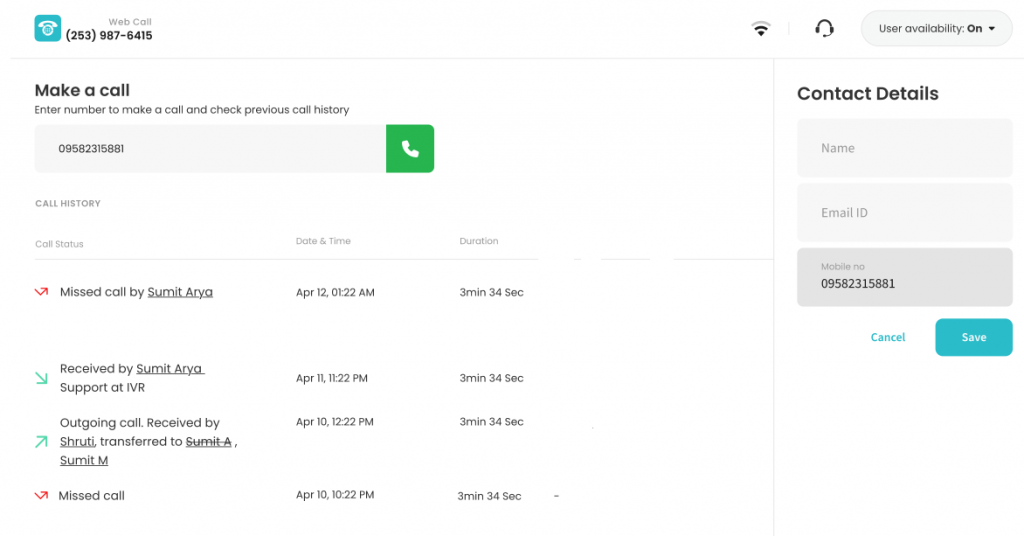
Imagine you’re a business owner, and you’ve got a list of potential clients or customers you want to reach out to. Instead of manually dialing each number and hoping someone picks up, what if your call center software could do it for you? Well, that’s where Outbound calling comes into play, and it’s like having your own proactive sales assistant.
Here’s how MyOperator’s Outbound calling feature works: Let’s say you run a real estate agency. You have a list of leads who’ve shown interest in your property listings. With a few clicks in your MyOperator dashboard, you schedule a series of automatic outbound calls to these leads.
Now, here’s the magic part – when your leads answer these calls, they’re greeted by an Interactive Voice Response (IVR) system. It’s like a friendly receptionist asking them to press a number to express their interest or leave a message.
For example, a potential buyer receives an outbound call. They hear, “Hello! We have some fantastic properties available. Press 1 if you’d like to schedule a viewing, or press 2 to leave a message.” The lead presses “1” because they’re interested.
The call is then automatically routed to one of your agents, who can assist the lead promptly. It’s like having a direct line from the interested customer to the right salesperson.
Additional Advanced Features
Live Call Transfer
- MyOperator’s live call transfer feature enables automatic, real-time call transfers from one agent to another. This ensures that customer inquiries are efficiently handed off to the most appropriate team member.
- Live call transfer reduces hold times, minimizes call abandonment rates, and ensures that customers receive timely and accurate support by connecting them with the right agent.
Call Masking
- MyOperator’s call masking feature safeguards customer privacy by hiding their personal phone numbers when making outbound calls. Instead, a temporary or virtual number is displayed to the recipient.
- Call masking enhances data security and customer confidentiality, making customers more comfortable with sharing their contact information. It’s particularly valuable for businesses handling sensitive information or privacy-conscious customers.
SMS & WhatsApp:
- MyOperator allows businesses to plan, schedule, and send text campaigns to leads through bulk SMS and WhatsApp API
- . This feature supports your marketing and customer engagement efforts.
- Bulk SMS and WhatsApp for business messaging enable businesses to reach a broader audience, promote products or services, and engage with customers efficiently through popular messaging platforms, improving communication outreach.
Live Panel
- MyOperator’s live panel provides a centralized dashboard where you can monitor your team’s performance and related activities in real-time. It offers a comprehensive view of call center operations.
- The live panel enables supervisors to stay informed about ongoing call center activities, ensuring that they can respond promptly to issues, allocate resources efficiently, and make informed decisions based on real-time data.
Speech Analytics
- MyOperator’s speech analytics feature leverages AI-driven speech and tonality recognition. It analyzes recorded calls to identify keywords, sentiments, and patterns in customer-agent interactions.
- Speech analytics provides valuable insights into customer behavior, agent performance, and call center efficiency. It helps businesses identify trends, improve customer service, and make data-driven decisions for continuous improvement.
How To Set Up MyOperator’s Cloud Call Center Software For Your Business

To get MyOperator Cloud Call Center Software for your business, you can follow these steps
Visit the MyOperator Website
Go to the official MyOperator website at https://www.myoperator.com/.
Explore Plans and Features
Browse through the available plans and features to determine which one suits your business needs.
MyOperator typically offers various subscription plans designed for businesses of different sizes and requirements.
Request a Demo
If you’re interested in the software but would like more information, you can request a demo.
MyOperator often provides personalized demos to showcase the software’s capabilities and answer any questions you may have.
Contact Sales
Contact the MyOperator sales team via the website, email, or phone to discuss your specific needs and pricing options. They can provide you with a quote tailored to your business requirements.
You can call the MyOperator support team 24/7 at +91 92129 92129 or 1800 123 7774. OR you can drop a mail at [email protected] and the sales team will reach out to you in no time.
Trial Period
MyOperator offers a 3-day free trial period for businesses to test the software and evaluate its suitability for your business. Grab the opportunity and evaluate the benefits of software for better understanding.
Sign Up and Installation
Once you’ve chosen a plan and reached an agreement with MyOperator, you’ll need to sign up for the service. The MyOperator team will guide you through the installation and setup process.
Training and Support
MyOperator typically offers training and support to help you and your team get started with the software. This may include user guides, video tutorials, and live support.
Integration and Customization
If necessary, work with MyOperator to integrate the software with your existing systems or customize it to align with your business processes.
Billing and Payment
Set up billing and payment according to the agreed-upon terms and pricing structure.
Launch and Implementation
Once everything is set up and configured, you can launch MyOperator Cloud Call Center Software for your business and start utilizing its holistic features to streamline your communication and customer support.
Conclusion
Selecting the best call center software provider is a pivotal decision for any organization.
By diligently considering your unique needs, exploring features, and assessing real-world performance, you can confidently choose the call center software that propel your business toward unmatched customer service and operational excellence
In this comprehensive guide, we’ve delved into the essential factors to consider when selecting call center software, from assessing your specific business needs to evaluating the features that align with your goals.
Additionally, we’ve examined real-world statistics and advanced MyOperator features that underscore the transformative power of making the right choice.
MyOperator, a leader in the industry, offers a comprehensive software solution that caters to these exact requirements.
With a proven track record, 10,000+ trusted customers, MyOperator has empowered businesses across diverse sectors, resulting in a remarkable 20% reduction in call abandonment rates and a significant 30% improvement in first-call resolution.
By seamlessly integrating interactive voice response (IVR solution), multi-channel support, CRM integration, and advanced analytics, MyOperator ensures that your communication operations run efficiently, boosting customer satisfaction and agent productivity.
Don’t just meet today’s communication challenges—exceed them. Choose MyOperator Cloud Contact Center Software, the trusted partner that has consistently delivered exceptional results in real-world scenarios.
Elevate your customer service and communication strategies with MyOperator and stay ahead in the competitive business landscape.


